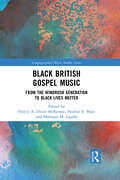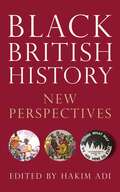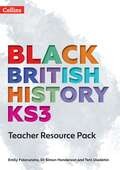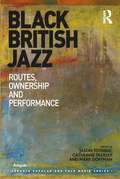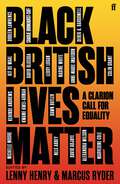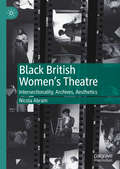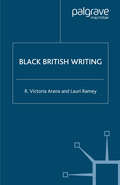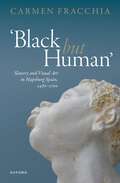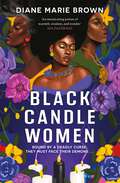- Table View
- List View
Black British Gospel Music: From the Windrush Generation to Black Lives Matter (Congregational Music Studies Series)
by Monique M. Ingalls Dulcie Dixon McKenzie Pauline MuirBlack British Gospel Music is a dynamic and multifaceted musical practice, a diasporic river rooted in the experiences of Black British Christian communities. This book examines gospel music in Britain in both historical and contemporary perspectives, demonstrating the importance of this this vital genre to scholars across disciplines. Drawing on a plurality of voices, the book examines the diverse streams that contribute to and flow out of this significant genre. Gospel can be heard resonating within a diverse array of Christian worship spaces; as a form of community music-making in school halls; and as a foundation for ‘secular’ British popular music, including R&B, hip hop and grime.
Black British Gospel Music: From the Windrush Generation to Black Lives Matter (Congregational Music Studies Series)
Black British Gospel Music is a dynamic and multifaceted musical practice, a diasporic river rooted in the experiences of Black British Christian communities. This book examines gospel music in Britain in both historical and contemporary perspectives, demonstrating the importance of this this vital genre to scholars across disciplines. Drawing on a plurality of voices, the book examines the diverse streams that contribute to and flow out of this significant genre. Gospel can be heard resonating within a diverse array of Christian worship spaces; as a form of community music-making in school halls; and as a foundation for ‘secular’ British popular music, including R&B, hip hop and grime.
Black British History: New Perspectives (Blackness in Britain)
by Hakim AdiFor over 1500 years before the Empire Windrush docked on British shores, people of African descent have played a significant and far-ranging role in the country's history, from the African soldiers on Hadrian's Wall to the Black British intellectuals who made London a hub of radical, Pan-African ideas. But while there has been a growing interest in this history, there has been little recognition of the sheer breadth and diversity of the Black British experience, until now.This collection combines the latest work from both established and emerging scholars of Black British history. It spans the centuries from the first Black Britons to the latest African migrants, covering everything from Africans in Tudor England to the movement for reparations, and the never ending struggles against racism in between.An invaluable resource for both future scholarship and those looking for a useful introduction to Black British history, Black British History: New Perspectives has the potential to transform our understanding of Britain, and of its place in the world.
Black British History: New Perspectives (Blackness in Britain)
by Hakim AdiFor over 1500 years before the Empire Windrush docked on British shores, people of African descent have played a significant and far-ranging role in the country's history, from the African soldiers on Hadrian's Wall to the Black British intellectuals who made London a hub of radical, Pan-African ideas. But while there has been a growing interest in this history, there has been little recognition of the sheer breadth and diversity of the Black British experience, until now.This collection combines the latest work from both established and emerging scholars of Black British history. It spans the centuries from the first Black Britons to the latest African migrants, covering everything from Africans in Tudor England to the movement for reparations, and the never ending struggles against racism in between.An invaluable resource for both future scholarship and those looking for a useful introduction to Black British history, Black British History: New Perspectives has the potential to transform our understanding of Britain, and of its place in the world.
Black British Intellectuals and Education: Multiculturalism’s hidden history
by Paul WarmingtonAsk any moderately interested Briton to name a black intellectual and chances are the response will be an American name: Malcolm X or Barack Obama, Toni Morrison or Cornel West. Yet Britain has its own robust black intellectual traditions and its own master teachers, among them C.L.R. James, Claudia Jones, Ambalavaner Sivanandan, Stuart Hall and Paul Gilroy. However, while in the USA black public intellectuals are an embedded, if often embattled, feature of national life, black British thinkers remain routinely marginalized. Black British Intellectuals and Education counters this neglect by exploring histories of race, education and social justice through the work of black British public intellectuals: academics, educators and campaigners. The book provides a critical history of diverse currents in black British intellectual production, from the eighteenth century, through post-war migration and into the ‘post-multicultural’ present, focusing on the sometimes hidden impacts of black thinkers on education and social justice. Firstly, it argues that black British thinkers have helped fundamentally to shape educational policy, practice and philosophy, particularly in the post-war period. Secondly, it suggests that education has been one of the key spaces in which the mass consciousness of being black and British has emerged, and a key site in which black British intellectual positions have been defined and differentiated. Chapters explore: • the early development of black British intellectual life, from the slave narratives to the anti-colonial movements of the early twentieth century • how African-Caribbean and Asian communities began to organize against racial inequalities in schooling in the post-Windrush era of the 1950s and 60s • how, from out of these grassroots struggles, black intellectuals and activists of the 1970s, 80s and 90s developed radical critiques of education, youth and structural racism • the influence of multiculturalism, black cultural studies and black feminism on education • current developments in black British educational work, including ‘post-racial’ approaches, Critical Race Theory and black social conservatism. Black British Intellectuals and Education will be of key relevance to undergraduates, postgraduates and academics engaged in research on race, ethnicity, education, social justice and cultural studies.
Black British Intellectuals and Education: Multiculturalism’s hidden history
by Paul WarmingtonAsk any moderately interested Briton to name a black intellectual and chances are the response will be an American name: Malcolm X or Barack Obama, Toni Morrison or Cornel West. Yet Britain has its own robust black intellectual traditions and its own master teachers, among them C.L.R. James, Claudia Jones, Ambalavaner Sivanandan, Stuart Hall and Paul Gilroy. However, while in the USA black public intellectuals are an embedded, if often embattled, feature of national life, black British thinkers remain routinely marginalized. Black British Intellectuals and Education counters this neglect by exploring histories of race, education and social justice through the work of black British public intellectuals: academics, educators and campaigners. The book provides a critical history of diverse currents in black British intellectual production, from the eighteenth century, through post-war migration and into the ‘post-multicultural’ present, focusing on the sometimes hidden impacts of black thinkers on education and social justice. Firstly, it argues that black British thinkers have helped fundamentally to shape educational policy, practice and philosophy, particularly in the post-war period. Secondly, it suggests that education has been one of the key spaces in which the mass consciousness of being black and British has emerged, and a key site in which black British intellectual positions have been defined and differentiated. Chapters explore: • the early development of black British intellectual life, from the slave narratives to the anti-colonial movements of the early twentieth century • how African-Caribbean and Asian communities began to organize against racial inequalities in schooling in the post-Windrush era of the 1950s and 60s • how, from out of these grassroots struggles, black intellectuals and activists of the 1970s, 80s and 90s developed radical critiques of education, youth and structural racism • the influence of multiculturalism, black cultural studies and black feminism on education • current developments in black British educational work, including ‘post-racial’ approaches, Critical Race Theory and black social conservatism. Black British Intellectuals and Education will be of key relevance to undergraduates, postgraduates and academics engaged in research on race, ethnicity, education, social justice and cultural studies.
Black British Jazz: Routes, Ownership and Performance (Ashgate Popular and Folk Music Series)
by Jason Toynbee Catherine TackleyBlack British musicians have been making jazz since around 1920 when the genre first arrived in Britain. This groundbreaking book reveals their hidden history and major contribution to the development of jazz in the UK. More than this, though, the chapters show the importance of black British jazz in terms of musical hybridity and the cultural significance of race. Decades before Steel Pulse, Soul II Soul, or Dizzee Rascal pushed their way into the mainstream, black British musicians were playing jazz in venues up and down the country from dance halls to tiny clubs. In an important sense, then, black British jazz demonstrates the crucial importance of musical migration in the musical history of the nation, and the links between popular and avant-garde forms. But the volume also provides a case study in how music of the African diaspora reverberates around the world, beyond the shores of the USA - the engine-house of global black music. As such it will engage scholars of music and cultural studies not only in Britain, but across the world.
Black British Jazz: Routes, Ownership and Performance (Ashgate Popular and Folk Music Series)
by Jason Toynbee Catherine TackleyBlack British musicians have been making jazz since around 1920 when the genre first arrived in Britain. This groundbreaking book reveals their hidden history and major contribution to the development of jazz in the UK. More than this, though, the chapters show the importance of black British jazz in terms of musical hybridity and the cultural significance of race. Decades before Steel Pulse, Soul II Soul, or Dizzee Rascal pushed their way into the mainstream, black British musicians were playing jazz in venues up and down the country from dance halls to tiny clubs. In an important sense, then, black British jazz demonstrates the crucial importance of musical migration in the musical history of the nation, and the links between popular and avant-garde forms. But the volume also provides a case study in how music of the African diaspora reverberates around the world, beyond the shores of the USA - the engine-house of global black music. As such it will engage scholars of music and cultural studies not only in Britain, but across the world.
Black British Lives Matter: A Clarion Call for Equality
by Lenny Henry Marcus RyderFeaturing essays from David Olusoga, Dawn Butler MP, Kit de Waal, Kwame Kwei-Armah, and many more.In response to the international outcry at George Floyd's death, Lenny Henry and Marcus Ryder have commissioned this collection of essays to discuss how and why we need to fight for Black lives to matter - not just for Black people but for society as a whole.Recognising Black British experience within the Black Lives Matter movement, nineteen prominent Black figures explain why Black lives should be celebrated when too often they are undervalued. Drawing from personal experience, they stress how Black British people have unique perspectives and experiences that enrich British society and the world; how Black lives are far more interesting and important than the forces that try to limit it."We achieve everything not because we are superhuman. We achieve the things we achieve because we are human. Our strength does not come from not having any weaknesses, our strength comes from overcoming them" Doreen Lawrence."I always presumed racism would always be here, that it was a given. But the truth is, it was not always here, it was invented." David Olusoga"Our identity and experience will shape every story, bleed into every poem, inform every essay whether it's about Black 'issues' or not" Kit de Waal
The Black British Quiz Book
by PrtyhereDive into this fun and entertaining quiz book from the UK’s biggest Black British pub quiz!
Black British Women's Theatre: Intersectionality, Archives, Aesthetics
by Nicola AbramThis book marks a significant methodological shift in studies of black British women’s theatre: it looks beyond published plays to the wealth of material held in archives of various kinds, from national repositories and themed collections to individuals’ personal papers. It finds there a cache of unpublished manuscripts and production recordings distinctive for their non-naturalistic aesthetics. Close analysis of selected works identifies this as an intersectional feminist creative practice. Chapters focus on five theatre companies and artists, spanning several decades: Theatre of Black Women (1982-1988), co-founded by Booker Prize-winning writer Bernardine Evaristo; Munirah Theatre Company (1983-1991); Black Mime Theatre Women’s Troop (1990-1992); Zindika; and SuAndi. The book concludes by reflecting on the politics of representation, with reference to popular postmillennial playwright debbie tucker green. Drawing on new interviews with the playwrights/practitioners and their peers, this book assembles a rich, interconnected, and occasionally corrective history of black British women’s creativity. By reproducing 22 facsimile images of flyers, production programmes, photographs and other ephemera, Black British Women’s Theatre: Intersectionality, Archives, Aesthetics not only articulates a hidden history but allows its readers their own encounter with the fragile record of this vibrant past.
Black British Writing
by Lauri RameyThis collection of essays provides an imaginative international perspective on ways to incorporate black British writing and culture in the study of English literature, and presents theoretically sophisticated and practical strategies for doing so. It offers a pedagogical, pragmatic and ideological introduction to the field for those without background, and an integrated body of current and stimulating essays for those who are already knowledgeable. Contributors to this volume include scholars and writers from Britain and the U.S. Following on recent developments in African American literature, postcolonial studies and race studies, the contributors invite readers to imagine an enhanced and inclusive British canon through varied essays providing historical information, critical analysis, cultural perspective, and extensive annotated bibliographies for further study.
'Black but Human': Slavery and Visual Art in Hapsburg Spain, 1480-1700
by Prof Carmen Fracchia'Black but Human' is the first study to focus on the visual representations of African slaves and ex-slaves in Spain during the Hapsburg dynasty. The Afro-Hispanic proverb 'Black but Human' is the main thread of the six chapters and serves as a lens through which to explore the ways in which a certain visual representation of slavery both embodies and reproduces hegemonic visions of enslaved and liberated Africans, and at the same time provides material for critical and emancipatory practices by Afro-Hispanics themselves. The African presence in the Iberian Peninsula between the late fifteenth century and the end of the seventeenth century was as a result of the institutionalization of the local and transatlantic slave trades. In addition to the Moors, Berbers, and Turks born as slaves, there were approximately two million enslaved people in the kingdoms of Castile, Aragón, and Portugal. The 'Black but Human' topos that emerges from the African work songs and poems written by Afro-Hispanics encodes the multi-layered processes through which a black emancipatory subject emerges and a 'black nation' forges a collective resistance. It is visually articulated by Afro-Hispanic and Spanish artists in religious paintings and in the genres of self-portraiture and portraiture. This extraordinary imagery coexists with the stereotypical representations of African slaves and ex-slaves by Spanish sculptors, engravers, jewellers, and painters mainly in the religious visual form and by European draftsmen and miniaturists, in their landscape drawings, and sketches for costume books.
'Black but Human': Slavery and Visual Art in Hapsburg Spain, 1480-1700
by Prof Carmen Fracchia'Black but Human' is the first study to focus on the visual representations of African slaves and ex-slaves in Spain during the Hapsburg dynasty. The Afro-Hispanic proverb 'Black but Human' is the main thread of the six chapters and serves as a lens through which to explore the ways in which a certain visual representation of slavery both embodies and reproduces hegemonic visions of enslaved and liberated Africans, and at the same time provides material for critical and emancipatory practices by Afro-Hispanics themselves. The African presence in the Iberian Peninsula between the late fifteenth century and the end of the seventeenth century was as a result of the institutionalization of the local and transatlantic slave trades. In addition to the Moors, Berbers, and Turks born as slaves, there were approximately two million enslaved people in the kingdoms of Castile, Aragón, and Portugal. The 'Black but Human' topos that emerges from the African work songs and poems written by Afro-Hispanics encodes the multi-layered processes through which a black emancipatory subject emerges and a 'black nation' forges a collective resistance. It is visually articulated by Afro-Hispanic and Spanish artists in religious paintings and in the genres of self-portraiture and portraiture. This extraordinary imagery coexists with the stereotypical representations of African slaves and ex-slaves by Spanish sculptors, engravers, jewellers, and painters mainly in the religious visual form and by European draftsmen and miniaturists, in their landscape drawings, and sketches for costume books.
The Black Butterfly: The Harmful Politics of Race and Space in America
by Lawrence T. BrownThe world gasped in April 2015 as Baltimore erupted and Black Lives Matter activists, incensed by Freddie Gray's brutal death in police custody, shut down highways and marched on city streets. In The Black Butterfly—a reference to the fact that Baltimore's majority-Black population spreads out on both sides of the coveted strip of real estate running down the center of the city like a butterfly's wings—Lawrence T. Brown reveals that ongoing historical trauma caused by a combination of policies, practices, systems, and budgets is at the root of uprisings and crises in hypersegregated cities around the country. Putting Baltimore under a microscope, Brown looks closely at the causes of segregation, many of which exist in current legislation and regulatory policy despite the common belief that overtly racist policies are a thing of the past. Drawing on social science research, policy analysis, and archival materials, Brown reveals the long history of racial segregation's impact on health, from toxic pollution to police brutality. Beginning with an analysis of the current political moment, Brown delves into how Baltimore's history influenced actions in sister cities like St. Louis and Cleveland, as well as its adoption of increasingly oppressive techniques from cities like Chicago. But there is reason to hope. Throughout the book, Brown offers a clear five-step plan for activists, nonprofits, and public officials to achieve racial equity. Not content to simply describe and decry urban problems, Brown offers up a wide range of innovative solutions to help heal and restore redlined Black neighborhoods, including municipal reparations. Persuasively arguing that because urban apartheid was intentionally erected it can be intentionally dismantled, The Black Butterfly demonstrates that America cannot reflect that Black lives matter until we see how Black neighborhoods matter.
The Black Butterfly: The Harmful Politics of Race and Space in America
by Lawrence T. BrownThe world gasped in April 2015 as Baltimore erupted and Black Lives Matter activists, incensed by Freddie Gray's brutal death in police custody, shut down highways and marched on city streets. In The Black Butterfly—a reference to the fact that Baltimore's majority-Black population spreads out on both sides of the coveted strip of real estate running down the center of the city like a butterfly's wings—Lawrence T. Brown reveals that ongoing historical trauma caused by a combination of policies, practices, systems, and budgets is at the root of uprisings and crises in hypersegregated cities around the country. Putting Baltimore under a microscope, Brown looks closely at the causes of segregation, many of which exist in current legislation and regulatory policy despite the common belief that overtly racist policies are a thing of the past. Drawing on social science research, policy analysis, and archival materials, Brown reveals the long history of racial segregation's impact on health, from toxic pollution to police brutality. Beginning with an analysis of the current political moment, Brown delves into how Baltimore's history influenced actions in sister cities like St. Louis and Cleveland, as well as its adoption of increasingly oppressive techniques from cities like Chicago. But there is reason to hope. Throughout the book, Brown offers a clear five-step plan for activists, nonprofits, and public officials to achieve racial equity. Not content to simply describe and decry urban problems, Brown offers up a wide range of innovative solutions to help heal and restore redlined Black neighborhoods, including municipal reparations. Persuasively arguing that because urban apartheid was intentionally erected it can be intentionally dismantled, The Black Butterfly demonstrates that America cannot reflect that Black lives matter until we see how Black neighborhoods matter.
The Black Cab Story (Story Ser.)
by Alf TownsendIn his new book, well-known London cabbie Alf Townsend tells us the complete story of the black cab, from its origins in the seventeenth century to the brand new taxis which now grace the capital’s streets. The history and development of the black cab is explored here in Alf’s straightforward writing style, alongside ninety colour and black and white images. This is a light-hearted romp through the world of ‘the knowledge’, the vehicles, the streets of London and the cabbies themselves, and is full of juicy snippets and fascinating quotes which will be of great interest to anyone who loves this London icon.
Black Cab Wisdom: Knowledge from the Back Seat
by Mark SolomonIn 2009, London cabbie Mark Solomon began asking passengers in the back of his taxi for a random quote or proverb. The project developed into a popular website (www.blackcabquotes.com), and this pocket-sized book offers the best thoughts for the day, ranging from the truly philosophical to the downright bizarre.
Black Camelot: African-American Culture Heroes in Their Times, 1960-1980
by William L. Van DeburgIn the wake of the Kennedy era, a new kind of ethnic hero emerged within African-American popular culture. Uniquely suited to the times, burgeoning pop icons projected the values and beliefs of the Civil Rights and Black Power movements, and reflected both the possibility and the actuality of a rapidly changing American landscape. In Black Camelot, William Van Deburg examines the dynamic rise of these new black champions, the social and historical contexts in which they flourished, and their powerful impact on the African-American community. "Van Deburg manages the enviable feat of writing with flair within a standardized academic framework, covering politics, social issues and entertainment with equal aplomb."—Jonathan Pearl, Jazz Times "[A] fascinating, thorough account of how African-American icons of the 1960s and '70s have changed the course of American history. . . . An in-depth, even-tempered analysis. . . . Van Deburg's witty, lively and always grounded style entertains while it instructs."—Publishers Weekly
Black Camelot: African-American Culture Heroes in Their Times, 1960-1980
by William L. Van DeburgIn the wake of the Kennedy era, a new kind of ethnic hero emerged within African-American popular culture. Uniquely suited to the times, burgeoning pop icons projected the values and beliefs of the Civil Rights and Black Power movements, and reflected both the possibility and the actuality of a rapidly changing American landscape. In Black Camelot, William Van Deburg examines the dynamic rise of these new black champions, the social and historical contexts in which they flourished, and their powerful impact on the African-American community. "Van Deburg manages the enviable feat of writing with flair within a standardized academic framework, covering politics, social issues and entertainment with equal aplomb."—Jonathan Pearl, Jazz Times "[A] fascinating, thorough account of how African-American icons of the 1960s and '70s have changed the course of American history. . . . An in-depth, even-tempered analysis. . . . Van Deburg's witty, lively and always grounded style entertains while it instructs."—Publishers Weekly
Black Camelot: African-American Culture Heroes in Their Times, 1960-1980
by William L. Van DeburgIn the wake of the Kennedy era, a new kind of ethnic hero emerged within African-American popular culture. Uniquely suited to the times, burgeoning pop icons projected the values and beliefs of the Civil Rights and Black Power movements, and reflected both the possibility and the actuality of a rapidly changing American landscape. In Black Camelot, William Van Deburg examines the dynamic rise of these new black champions, the social and historical contexts in which they flourished, and their powerful impact on the African-American community. "Van Deburg manages the enviable feat of writing with flair within a standardized academic framework, covering politics, social issues and entertainment with equal aplomb."—Jonathan Pearl, Jazz Times "[A] fascinating, thorough account of how African-American icons of the 1960s and '70s have changed the course of American history. . . . An in-depth, even-tempered analysis. . . . Van Deburg's witty, lively and always grounded style entertains while it instructs."—Publishers Weekly
The Black Campus Movement: Black Students and the Racial Reconstitution of Higher Education, 1965–1972 (Contemporary Black History)
by Ibram X. KendiThis book provides the first national study of this intense and challenging struggle which disrupted and refashioned institutions in almost every state. It also illuminates the context for one of the most transformative educational movements in American history through a history of black higher education and black student activism before 1965.
Black Candle Women: a spellbinding story of family, heartache, and a fatal Voodoo curse
by Diane Marie Brown'[An] evocative and tender book . . . everyone who reads it will be enchanted like I was' ⭐ ⭐ ⭐ ⭐ ⭐ reader review'Propulsive and poignant, Black Candle Women concocts an intoxicating potion of warmth, wisdom, and wonder. This gorgeous debut novel is a sweepingly fashioned love story where romance and rebellion intertwine with fear and family. And the stakes are epic. I was completely and gladly under Ms. Brown's spell' AVA DUVERNAY'A big-hearted debut, with complex, flawed, and compelling characters I was rooting for every step of the way' E.M. TRAN'Richly imagined and elegantly told, with plenty of satisfying secrets, heartaches, and twists' SADEQA JOHNSON'A spellbinding romp. The Montrose women will have you clutching your pearls on this rollercoaster of a debut' CAROLYN HUYNH'Written with warmth and an eye for detail, Diane Marie Brown's Black Candle Women explores the bonds of family and the magical power of belief to transform our lives' SHAUNA J. EDWARDS & ALYSON RICHMAN'Black Candle Women is a compassionate novel about motherhood, sisterhood, independence, and the reflection and forgiveness required to break generational curses' DE'SHAWN CHARLES WINSLOW 'Brown deftly portrays an insular family of women in all of its complicated glory . . . The spiritual angle gives this powerful family drama a magical twist that will delight readers' BOOKLIST (starred review)'Black Candle Women is a bold and tender story about three generations of women each attempting to find their way amidst the gifts and curses they've inherited . . . This novel is a wondrous celebration of womanhood' CLEYVIS NATERA*************************************'All of you are cursed, you hear me?An ugly death for the ones with whom you fall in love'For generations, the Montrose women have lived alone with their secrets, their delicate peace depending on the unspoken bond that underpins their family life - Voodoo and hoodoo magic, and a decades-old curse that will kill anyone they fall for.When seventeen-year-old Nickie Montrose brings home a boy for the first time, this careful balance is thrown into disarray. For the other women have been keeping the curse from Nickie, and revealing it means that they must reckon with their own choices and mistakes.As new truths emerge, the Montrose women are set on a collision course that echoes back to New Orleans' French Quarter, where a crumbling book of spells may hold the answers that all of them have been looking for...Rich in its sense of character and place, Black Candle Women is a haunting and magical debut from a talented new storyteller.*************************************Early readers are LOVING Black Candle Women!'I LOVED IT SO SO MUCH. Magic? A cursed family tree? Badass women? This was an adventure from start to finish and it was my pleasure to read''What a fascinating story about some amazing women. I was caught on page one and stayed captivated until the very end. Bravo!!''This book was amazing from start to finish. I was so captivated by each of the characters''I was invested from the first page and really loved these characters and their story'
Black Cat in the Window: A Family Album with Much Love and Squalor
by Liam Ó MurchúThere is a large floor of broken boards, covered here and there with bit and pieces of broken linoleum. I cannot see the walls or what's above them, but there is a woman at a fire who keeps looking at me, and a man on a chair reading a paper, who keeps looking at me.' Born in a fourth-floor tenement, the youngest of twelve, Liam was the son of a Dublin Fusilier and a flaxmill worker. Although half his siblings were dead before he was born, he does not 'look back in anger' but at people's tough resolve not to be bitter about life's lot and see the next generation through to better times. Set in the territory of Frank O'Connor on Cork's north side, this is not another sorry tale of childhook poverty. It is a memoir of courage and endurance, telling an often uproarious and always poignant story. Alive with the yowling of cats and scurrying of rats, the ghosts of Blarney and Shandon Street appear – ex-soldiers, money lenders, fruit-sellers and women overwhelmed by children, drink and galloping consumption. For some it ended with their head in a gas oven or with long tresses floating through the weir grass on the quiet waters of the River Lee. 'A black cat in the window' - was it a sign of luck? With six alive at least there was a chance. Despite the taboos of a strict time there was still some sex in a damp climate, some great heroes and heroines, and a bicycle in the hallway was a sure sign of upward mobility.
